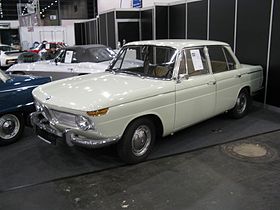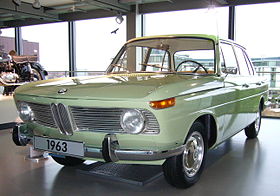BMW 1500
| BMW New Class | |
|---|---|

BMW 1600
|
|
| Overview | |
| Manufacturer | BMW |
| Production | 1962–1977 |
| Assembly |
Munich, Germany Jakarta, Indonesia () |
| Body and chassis | |
| Body style | 4-door sedan 2-door GT coupe |
| Layout | FR layout |
| Related | BMW 02 Series |
| Powertrain | |
| Engine | 1.5-2.0 L M10 4-cyl |
| Chronology | |
| Successor |
BMW 5 Series for sedans BMW E9 for coupes |
| BMW New Class sedan | |
|---|---|

BMW 1500
|
|
| Overview | |
| Also called | 1500, 1800, 1800 TI, 1800TI/SA, 1600, 2000, 2000 TI, 2000 tilux, 2000 tii |
| Production |
1500: 1962–1964 1800: 1963–1971 1600: 1964–1971 2000: 1966–1972 |
| Designer |
Wilhelm Hofmeister Giovanni Michelotti, consultant |
| Body and chassis | |
| Class | Mid-size luxury / Executive car (E) |
| Body style | 4-door sedan |
| Powertrain | |
| Engine |
M10 4-cyl 1500: 1,499 cc 1800: 1,773 cc (1964–1968), 1,766 cc (1968–1971) 1600: 1573 cc 2000: 1,990 cc |
| Transmission | 4-speed manual 5-speed manual on 1800 TI/SA 3-speed automatic optional on 1800/2000 |
| Dimensions | |
| Wheelbase | 2,550 mm (100 in) |
| Length | 4,500 mm (180 in) |
| Width | 1,650 mm (65 in) |
| Height | 1,420 mm (56 in) |
| Chronology | |
| Successor | BMW E12 (BMW 5-Series) |
| BMW 2000 C BMW 2000 CS |
|
|---|---|

BMW 2000 CS
|
|
| Overview | |
| Manufacturer | BMW |
| Production | 1965-1969 |
| Assembly | by Karmann at Osnabrück |
| Designer | Wilhelm Hofmeister |
| Body and chassis | |
| Class | Grand tourer (S) |
| Body style | 2-door coupé |
| Layout | FR layout |
| Platform | BMW New Class |
| Related | BMW New Class BMW E9 |
| Powertrain | |
| Engine | 2.0 L OHC I4 2000C: single carburettor, 100 hp (75 kW) at 5500 rpm 2000CS: two carburettors, 120 hp (89 kW) at 5500 rpm |
| Transmission | 4 speed manual 3 speed automatic (available on 2000C only) |
| Dimensions | |
| Wheelbase | 2,550 mm (100 in) |
| Length | 4,530 mm (178 in) |
| Width | 1,675 mm (65.9 in) |
| Height | 1,360 mm (54 in) |
| Chronology | |
| Predecessor | BMW 3200 CS |
| Successor | BMW 2800CS |
The BMW New Class (German: Neue Klasse) was a line of sedans and coupes produced by German automaker BMW between 1962 and 1977. These models ensured BMW's solvency after the company's financial crisis of the 1950s and established the identity of BMW automobiles as sports sedans.
The first New Class vehicle was the 1500, a 4-door compact executive car with the new M10 (at the time called M115) OHC 4-cylinder engine. In 1965, the 2000C and 2000CS luxury coupés were added to the range.
Replacement of the New Class models began with the larger 2000C and 2000CS coupés, which were replaced by the 6-cylinder E9 2800CS in 1969. In 1972, the 4-door sedans were replaced by the larger E12 5 Series.
The New Class coupes introduced the Hofmeister kink, which has been used on most BMW cars since. Another legacy of the New Class is the iconic 02 Series, which are a shortened version of the New Class sedans.
During the 1950s, the BMW line-up consisted of luxury cars with displacements of two litres or greater, economy cars powered by motorcycle engines, and motorcycles. With their luxury cars becoming increasingly outdated and unprofitable and their motorcycles and economy cars becoming less attractive to an increasingly affluent society, BMW needed a car in the 1.5 to 2 litre class to become competitive. Prototypes powered by a 1.6 L engine based on one bank of the BMW OHV V8 engine were built and evaluated without a convincing result.
In 1960, Herbert and Harald Quandt invested heavily in BMW, and gained a controlling interest in the company. That year, the "Neue Klasse" project was begun. Led overall by Fritz Fiedler, the project had Eberhard Wolff in charge of chassis design, Wilhelm Hofmeister in charge of styling and body engineering, and Alex von Falkenhausen in charge of engine design. The team was to produce a new car with a new engine, which BMW had not done since the 303 in 1933.
...
Wikipedia
